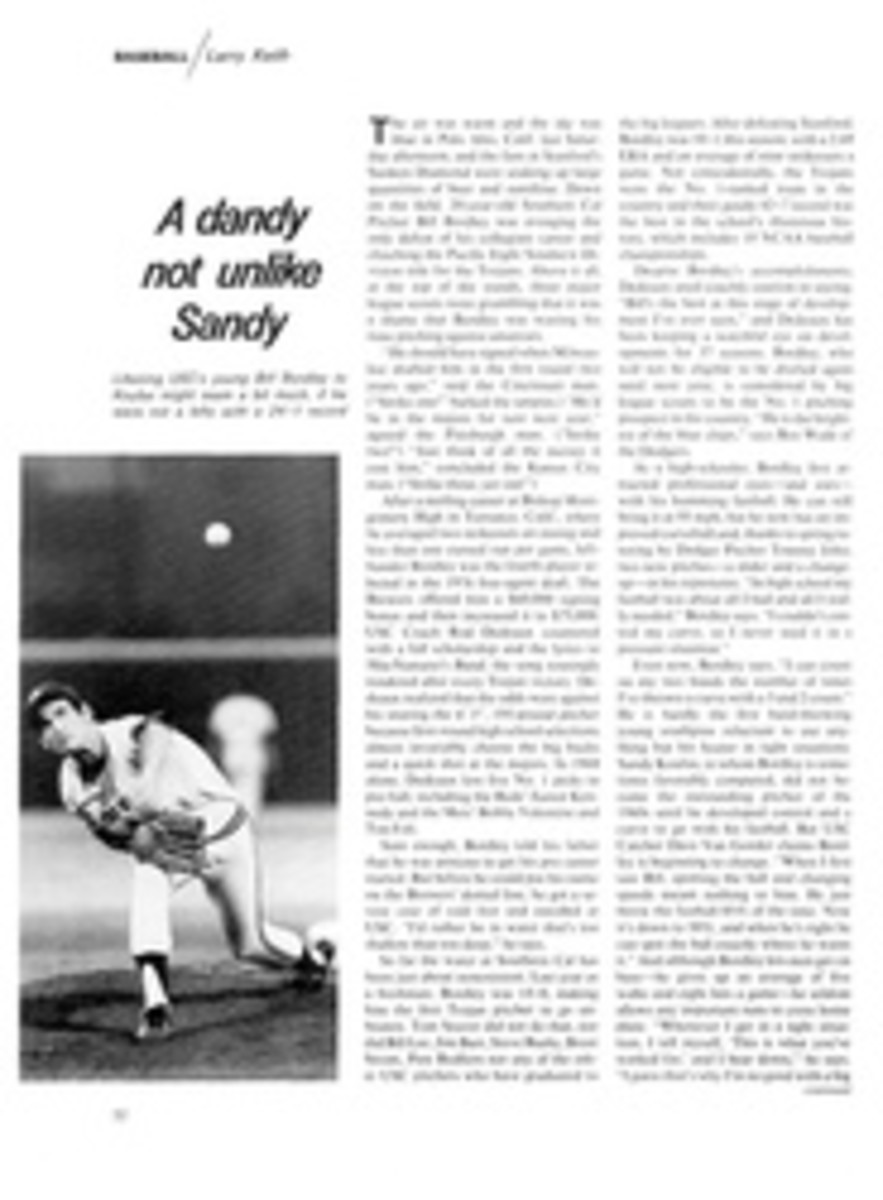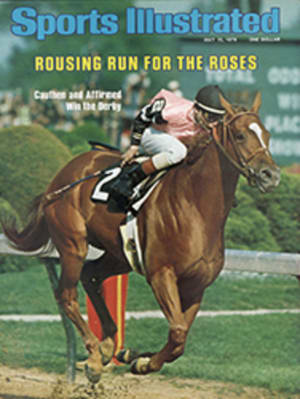
A dandy not unlike Sandy
The air was warm and the sky was blue in Palo Alto, Calif. last Saturday afternoon, and the fans at Stanford's Sunken Diamond were soaking up large quantities of beer and sunshine. Down on the field, 20-year-old Southern Cal Pitcher Bill Bordley was avenging the only defeat of his collegiate career and clinching the Pacific Eight Southern Division title for the Trojans. Above it all, at the top of the stands, three major league scouts were grumbling that it was a shame that Bordley was wasting his time pitching against amateurs.
"He should have signed when Milwaukee drafted him in the first round two years ago," said the Cincinnati man. ("Strike one!" barked the umpire.) "He'd be in the majors for sure next year," agreed the Pittsburgh man. ("Strike two!") "Just think of all the money it cost him," concluded the Kansas City man. ("Strike three, yer out!")
After a sterling career at Bishop Montgomery High in Torrance, Calif., where he averaged two strikeouts an inning and less than one earned run per game, lefthander Bordley was the fourth player selected in the 1976 free-agent draft. The Brewers offered him a $60,000 signing bonus and then increased it to $75,000. USC Coach Rod Dedeaux countered with a full scholarship and the lyrics to MacNamara's Band, the song rousingly rendered after every Trojan victory. Dedeaux realized that the odds were against his snaring the 6'3", 195-pound pitcher because first-round high school selections almost invariably choose the big bucks and a quick shot at the majors. In 1968 alone, Dedeaux lost five No. 1 picks to pro ball, including the Reds' Junior Kennedy and the Mets' Bobby Valentine and Tim Foli.
Sure enough, Bordley told his father that he was anxious to get his pro career started. But before he could put his name on the Brewers' dotted line, he got a severe case of cold feet and enrolled at USC. "I'd rather be in water that's too shallow than too deep," he says.
So far the water at Southern Cal has been just about nonexistent. Last year as a freshman, Bordley was 14-0, making him the first Trojan pitcher to go unbeaten. Tom Seaver did not do that, nor did Bill Lee, Jim Barr, Steve Busby, Brent Strom, Pete Redfern nor any of the other USC pitchers who have graduated to the big leagues. After defeating Stanford, Bordley was 10-1 this season, with a 2.69 ERA and an average of nine strikeouts a game. Not coincidentally, the Trojans were the No. 1-ranked team in the country and their gaudy 42-7 record was the best in the school's illustrious history, which includes 10 NCAA baseball championships.
Despite Bordley's accomplishments, Dedeaux used coachly caution in saying, "Bill's the best at this stage of development I've ever seen," and Dedeaux has been keeping a watchful eye on developments for 37 seasons. Bordley, who will not be eligible to be drafted again until next year, is considered by big league scouts to be the No. 1 pitching prospect in the country. "He is the brightest of the blue chips," says Ben Wade of the Dodgers.
As a high-schooler, Bordley first attracted professional eyes—and ears—with his humming fastball. He can still bring it at 95 mph, but he now has an improved curveball and, thanks to spring tutoring by Dodger Pitcher Tommy John, two new pitches—a slider and a change-up—in his repertoire. "In high school my fastball was about all I had and all I really needed," Bordley says. "I couldn't control my curve, so I never used it in a pressure situation."
Even now, Bordley says, "I can count on my two hands the number of times I've thrown a curve with a 3 and 2 count." He is hardly the first hard-throwing young southpaw reluctant to use anything but his heater in tight situations. Sandy Koufax, to whom Bordley is sometimes favorably compared, did not become the outstanding pitcher of the 1960s until he developed control and a curve to go with his fastball. But USC Catcher Dave Van Gorder claims Bordley is beginning to change. "When I first saw Bill, spotting the ball and changing speeds meant nothing to him. He just threw the fastball 85% of the time. Now it's down to 50%, and when he's right he can spot the ball exactly where he wants it." And although Bordley lets men get on base—he gives up an average of five walks and eight hits a game—he seldom allows any important runs to cross home plate. "Whenever I get in a tight situation, I tell myself, 'This is what you've worked for,' and I bear down," he says. "I guess that's why I'm no good with a big lead. I pitch best when the game is close."
He gave up 10 earned runs in one game this year, seven in another. Last Saturday, after striking out three of the first six Stanford batters, he struggled the rest of the way, and it looked as if he was going to duplicate his only collegiate defeat, a 3-2 loss to Stanford three weeks before. But Third Baseman Dave Engel's two-run homer in the ninth and Jeff Schattinger's last-out relief handed Bordley a 4-3 victory.
"Bill is really just a baby," says Dedeaux, "but he is way ahead of schedule. I'd say that after one more season here and a year of Triple A, he'll be ready to move into the majors."
PHOTO

